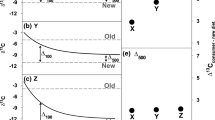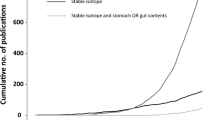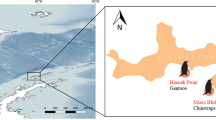Abstract
The foraging ecology of elasmobranchs (sharks, skates, and rays) is difficult to study because species have spatially and temporally diverse diets. Many diet and habitat preference studies for mammals, birds, and teleosts use stable isotope analysis, but interpretations are limited for elasmobranch studies because taxon-specific isotope discrimination factors from a controlled experiment are unavailable. Trophic discrimination factors for plasma, red blood cells, and muscle were determined from an experiment with leopard sharks (Triakis semifasciata) fed a constant diet of squid over 1000 days. The δ13C values for shark tissues at equilibrium with the squid diet did not vary significantly among individuals, but plasma and red blood cell δ15N values differed significantly among individuals and sampling day. Individual variation of muscle δ15N averages was observed and likely related to growth. Overall, carbon and nitrogen discrimination factors corresponded to previous studies featuring high-protein diets and carnivorous taxa. The muscle-to-diet discrimination factors from the controlled feeding study were applied to blue sharks (Prionace glauca) and smooth hammerhead sharks (Sphyrna zygaena) caught offshore from Baja California, Mexico. This case study demonstrates the potential of stable isotope analysis to illuminate differences in foraging patterns between elasmobranch species.



Similar content being viewed by others
Notes
For ease of communication, we will refer to these as discrimination factors and omit the subscripts on Δ values. Δ values are most often used because they are trivial to calculate and accurate as long as the difference in δ values between diet and tissue is small (< 10‰, Cerling and Harris 1999).
References
Ambrose SH, DeNiro MJ (1986) Reconstruction of African human diet using bone collagen carbon and nitrogen isotope ratios. Nature 319:321–324
Araya M, Cubillos LA (2006) Evidence of two-phase growth in elasmobranchs. Environ Biol Fish 77:293–300
Ballantyne JS (1997) Jaws: the inside story. The metabolism of elasmobranch fishes. Comp Biochem Physiol B Biochem Mol Biol 118:703–742
Barnes C, Jennings S, Barry JT (2009) Environmental correlates of large-scale spatial variation in the δ13C of marine animals. Estuar Coast Shelf Sci 81:368–374
Baum JK, Myers RA, Kehler DG, Worm B, Harley SJ, Doherty PA (2003) Collapse and conservation of shark populations in the Northwest Atlantic. Science 299:389–392
Bocherens H, Drucker D (2003) Trophic level isotopic enrichment of carbon and nitrogen in bone collagen: Case studies from recent and ancient terrestrial ecosystems. International Journal of Osteoarchaeology 13:46–53
Bodin N, Budzinski H, Le Menach K, Tapie N (2009) ASE extraction method for simultaneous carbon and nitrogen stable isotope analysis in soft tissues of aquatic organisms. Anal Chim Acta 643:54–60
Broomell CC, Khan RK, Moses DN, Miserez A, Pontin MG, Stucky GD, Zok FW, Waite JH (2007) Mineral minimization in nature’s alternative teeth. J R Soc Interface 4:19–31
Carlisle AB, Starr RM (2009) Habitat use, residency, and seasonal distribution of female leopard sharks Triakis semifasciata in Elkhorn Slough, California. Mar Ecol Progr 380:213–228
Cartamil D, Santana-Morales O, Escobedo-Olvera M, Kacev D, Castillo-Geniz L, Graham JB, Rubin RD, Sosa-Nishizaki O (2011) The artisanal elasmobranch fishery of the Pacific coast of Baja California, Mexico. Fisheries Research 108:393–403
Casper BM, Domingo A, Gaibor N et al. (2005) Sphyrna zygaena. In: IUCN 2010. IUCN Red List of Threatened Species. Version 2010.4. <www.iucnredlist.org>. Downloaded on 04 May 2011.
Cerling TE, Harris JM (1999) Carbon isotope fractionation between diet and bioapatite in ungulate mammals and implications for ecological and paleoecological studies. Oecologia 120:347–363
Clementz MT, Koch PL (2001) Differentiating aquatic mammal habitat and foraging ecology with stable isotopes in tooth enamel. Oecologia 129:461–472
Crawford K, McDonald RA, Bearhop S (2008) Applications of stable isotope techniques to the ecology of mammals. Mamm Rev 38:87–107
Dobush GR, Ankney CD, Krementz DG (1985) The effect of apparatus, extraction time, and solvent type on lipid extractions of snow geese. Can J Zool 63:1917–1920
Domi N, Bouquegneau JM, Das K (2005) Feeding ecology of five commercial shark species of the Celtic Sea through stable isotope and trace metal analysis. Mar Environ Res 60:551–569
Dulvy NK, Metcalfe JD, Glanville J, Pawson MG, Reynolds JD (2000) Fishery stability, local extinctions, and shifts in community structure in skates. Conserv Biol 14:283–293
Dulvy NK, Baum JK, Clarke S, Compagno LJV, Cortes E, Domingo A, Fordham S, Fowler S, Francis MP, Gibson C, Martinez J, Musick JA, Soldo A, Stevens JD, Valenti S (2008) You can swim but you can’t hide: the global status and conservation of oceanic pelagic sharks and rays. Aquat Conserv Mar Freshwat Ecosyst 18:459–482
Estrada JA, Rice AN, Lutcavage ME, Skomall GB (2003) Predicting trophic position in sharks of the north-west Atlantic Ocean using stable isotope analysis. Journal of the Marine Biological Association of the United Kingdom 83:1347–1350
Farrer DA (2009) Northern Range Extension of the Leopard Shark, Triakis Semifasciata. Calif Fish Game 95:62–64
Fisk AT, Tittlemier SA, Pranschke JL, Norstrom RJ (2002) Using anthropogenic contaminants and stable isotopes to assess the feeding ecology of Greenland sharks. Ecology 83:2162–2172
Florin ST, Felicetti LA, Robbins CT (2011) The biological basis for understanding and predicting dietary-induced variation in nitrogen and sulphur isotope ratio discrimination. Funct Ecol 25:519–526
Focken U (2001) Stable isotopes in animal ecology: the effect of ration size on the trophic shift of C and N isotopes between feed and carcass. Isotopes Environ Health Stud 37:199–211
Fogel ML, Tuross N (2003) Extending the limits of paleodietary studies of humans with compound specific carbon isotope analysis of amino acids. J Archaeol Sci 30:535–545
Fogel ML, Tuross N, Johnson BJ, Miller GH (1997) Biogeochemical record of ancient humans. Org Geochem 27:275–287
Fox-Dobbs K, Bump JK, Peterson RO, Fox DL, Koch PL (2007) Carnivore-specific stable isotope variables and variation in the foraging ecology of modern and ancient wolf populations: case studies from Isle Royale, Minnesota, and La Brea. Can J Zool 85:458–471
Gannes LZ, O’Brien DM, Martínez del Rio C (1997) Stable isotopes in animal ecology: assumptions, caveats, and a call for more laboratory experiments. Ecology 78:1271–1276
Gannes LZ, Martínez del Rio C, Koch P (1998) Natural abundance variations in stable isotopes and their potential uses in animal physiological ecology. Comp Biochem Physiol Mol Integr Physiol 119:725–737
Gendron D, Aguíñiga S, Carriquiry JD (2001) δ15N and δ13C in skin biopsy samples: a note on their applicability for examining the relative trophic level in three rorqual species. Journal of Cetacean Research and Management 3:1–4
Gould P, Ostrom P, Walker W (1997) Trophic relationships of albatrosses associated with squid and largemesh drift-net fisheries in the North Pacific Ocean. Can J Zool 75:549–562
Grellier K, Hammond PS (2006) Robust digestion and passage rate estimates for hard parts of grey seal (Halichoerus grypus) prey. Can J Fish Aquat Sci 63:1982–1998
Hare PE, Fogel ML, Stafford TW, Mitchell AD, Hoering TC (1991) The isotopic composition of carbon and nitrogen in individual amino acids isolated from modern and fossil proteins. J Archaeol Sci 18:277–292
Hazon N, Wells A, Anderson G, Good J, Pillans R, Franklin C (2007) Osmoregulation in elasmobranch fish—a review. Comp Biochem Physiol Mol Integr Physiol 146:S87–S96
Hernández-Aguilar SB (2008) Espectro trófico del tiburón azul Prionace glauca (Linnaeus, 1758) en la costa occidental de Baja California Sur, México (MS Thesis). Centro Interdisciplinario de Ciencias Marinas. La Paz, Mexico.
Hilderbrand GV, Farley SD, Robbins CT, Hanley TA, Titus K, Servheen C (1996) Use of stable isotopes to determine diets of living and extinct bears. Can J Zool 74:2080–2088
Hobson KA, Cherel Y (2006) Isotopic reconstruction of marine food webs using cephalopod beaks: new insight from captively raised Sepia officinalis. Can J Zool 84:766–770
Hobson KA, Clark RG (1992a) Assessing avian diets using stable isotopes I: turnover of 13C in tissues. Condor 94:181–188
Hobson KA, Clark RG (1992b) Assessing avian diets using stable isotopes II: factors influencing diet-tissue fractionation. Condor 94:189–197
Hobson KA, Schell DM, Renouf D, Noseworthy E (1996) Stable carbon and nitrogen isotopic fractionation between diet and tissues of captive seals: implications for dietary reconstructions involving marine mammals. Can J Fish Aquat Sci 53:528–533
Hussey NE, Brush J, McCarthy ID, Fisk AT (2010) δ15N and δ13C diet-tissue discrimination factors for large sharks under semi-controlled conditions. Comp Biochem Physiol Mol Integr Physiol 155:445–453
Inger R, Bearhop S (2008) Applications of stable isotope analyses to avian ecology. Ibis 150:447–461
Ivlev AA, Knyazev YA, Logachev MF (1996) Daily average carbon isotope composition of CO2 of expired air and urine urea in normal states and some endocrine pathologies in man. Biofizika 41:508–516
Kelly JF (2000) Stable isotopes of carbon and nitrogen in the study of avian and mammalian trophic ecology. Can J Zool 78:1–27
Kim SL, Koch PL (in press) Methods to collect, preserve, and prepare elasmobranch tissues for stable isotope analysis. Environ Biol Fish.
Knobbe N, Vogl J, Pritzkow W, Panne U, Fry H, Lochotzke HM, Preiss Weigert A (2006) C and N stable isotope variation in urine and milk of cattle depending on the diet. Anal Bioanal Chem 386:104–108
Koch PL (2007) Isotopic study of the biology of modern and fossil vertebrates. In: Michener R, Lajtha K (eds) Stable isotopes in ecology and environmental science, 2nd edn. Blackwell Publishing, Boston, pp 99–154
Kurle CM (2002) Stable-isotope ratios of blood components from captive northern fur seals (Callorhinus ursinus) and their diet: applications for studying the foraging ecology of wild otariids. Can J Zool 80:902–909
Layman CA, Arrington DA, Montana CG, Post DM (2007) Can stable isotope ratios provide for community-wide measures of trophic structure? Ecology 88:42–48
Logan JM, Lutcavage ME (2010) Stable isotope dynamics in elasmobranch fishes. Hydrobiologia 644:231–244
Lorrain A, Graham B, Ménard F, Popp B, Bouillon S, van Breugel P, Cherel Y (2009) Nitrogen and carbon isotope values of individual amino acids: a tool to study foraging ecology of penguins in the Southern Ocean. Mar Ecol Progr 391:293–306
Macko SA, Estep Fogel ML, Engel MH, Hare PE (1986) Kinetic fractionation of stable nitrogen isotopes during amino acid transamination. Geochim Cosmochim Acta 50:2143–2146
MacNeil MA, Skomal GB, Fisk AT (2005) Stable isotopes from multiple tissues reveal diet switching in sharks. Mar Ecol Progr 302:119–206
MacNeil MA, Drouillard KG, Fisk AT (2006) Variable uptake and elimination of stable nitrogen isotopes between tissues in fish. Can J Fish Aquat Sci 63:345–353
Martínez del Rio C, Wolf N, Carleton SA, Gannes LZ (2009) Isotopic ecology ten years after a call for more laboratory experiments. Biol Rev 84:91–111
McClelland JW, Montoya JP (2002) Trophic relationships and the nitrogen isotopic composition of amino acids in plankton. Ecology 83:2173–2180
Moore JW, Semmens BX (2008) Incorporating uncertainty and prior information into stable isotope mixing models. Ecol Lett 11:470–480
Myers RA, Baum JK, Shepherd TD, Powers SP, Peterson CH (2007) Cascading effects of the loss of apex predatory sharks from a coastal ocean. Science 315:1846–1850
Nakano H, Stevens JD (2008) The biology and ecology of the blue shark, Prionace glauca. In: Camhi MD, Pikitch EK, Babcock EA (eds) Sharks of the open ocean: biology, fisheries, and conservation. Blackwell Publishing Ltd, Ames, pp 140–151
Nardoto GB, Ferraz PDG, de Barros ES, Ometto J, Martinelli LA (2006) Stable carbon and nitrogen isotopic fractionation between diet and swine tissues. Scientia Agricola 63:579–582
Newsome SD, Etnier MA, Gifford-Gonzalez D, Phillips DL, van Tuinen M, Hadly EA, Costa DP, Kennett DJ, Guilderson TP, Koch PL (2007) The shifting baseline of northern fur seal ecology in the northeast Pacific Ocean. Proc Natl Acad Sci USA 104:9709–9714
Newsome SD, Clementz MT, Koch PL (2010) Using stable isotope biogeochemistry to study marine mammal ecology. Mar Mamm Sci 26:509–572
O’Brien DM, Boggs CL, Fogel ML (2005) The amino acids used in reproduction by butterflies: a comparative study of dietary sources using compound-specific stable isotope analysis. Physiol Biochem Zool 78:819–827
Ochoa-Díaz R (2009) Espectro trófico del tiburón martillo Sphyrna zygaena (Linnaeus, 1758) en Baja California Sur: Aplicación de δ13C y δ15N (MS Thesis) Centro Interdisciplinario de Ciencias Marinas. La Paz, Mexico.
Oelbermann K, Scheu S (2002) Stable isotope enrichment (δ15N and δ13C) in a generalist predator (Pardosa lugubris, Araneae: Lycosidae): effects of prey quality. Oecologia 130:337–344
Ostrom PH, Lien J, Macko SA (1993) Evaluation of the diet of sowerby’s beaked whale, Mesoplodon bidens, based on isotopic comparisons among northwestern Atlantic cetaceans. Can J Zool 71:858–861
Passey BH, Robinson TF, Ayliffe LK, Cerling TE, Sponheimer M, Dearing MD, Roeder BL, Ehleringer JR (2005) Carbon isotope fractionation between diet, breath CO2, and bioapatite in different mammals. J Archaeol Sci 32:1459–1470
Pearson SF, Levey DJ, Greenberg CH, Martínez del Rio C (2003) Effects of elemental composition on the incorporation of dietary nitrogen and carbon isotopic signatures in an omnivorous songbird. Oecologia 135:516–523
Pinnegar JK, Polunin NVC (1999) Differential fractionation of δ13C and δ15N among fish tissues: implications for the study of trophic interactions. Funct Ecol 13:225–231
Popp BN, Graham BS, Olson RJ, Hannides CCS, Lott MJ, Lopez-Ibarra GA, Galvan-Magaña F, Fry B (2007) Insight into the trophic ecology of yellowfin tuna, Thunnus albacares, from compound-specific nitrogen isotope analysis of protenaceous amino acids. In: Dawson, T. and Siegwolf, R. (eds) Stable isotopes as indicators of ecological change. Elsevier/Academic Press. pp. 173–190.
Post DM (2002) Using stable isotopes to estimate trophic position: models, methods, and assumptions. Ecology 83:703–718
Ritchie EG, Johnson CN (2009) Predator interactions, mesopredator release and biodiversity conservation. Ecol Lett 12:982–998
Robbins CT, Felicetti LA, Sponheimer M (2005) The effect of dietary protein quality on nitrogen isotope discrimination in mammals and birds. Oecologia 144:534–540
Ruiz-Cooley RI, Markaida U, Gendron D, Aguiñiga S (2006) Stable isotopes in jumbo squid (Dosidicus gigas) beaks to estimate its trophic position: comparison between stomach contents and stable isotopes. Journal of the Marine Biological Association of the United Kingdom 86:437–445
Saino T, Hattori A (1987) Geographical variation of the water column distribution of suspended particulate organic nitrogen and its 15N natural abundance in the Pacific and its marginal Seas. Deep Sea Res Oceanogr Res Paper 34:807–827
Saupe SM, Schell DM, Griffiths WB (1989) Carbon-isotope ratio gradients in western arctic zooplankton. Mar Biol 103:427–432
Sholto-Douglas AD, Field JG, James AG, van der Merwe NJ (1991) 13C/12C and 15N/14N Isotope Ratios in the Southern Benguela Ecosystem: indicators of food web relationships among different size-classes of plankton and pelagic fish; differences between fish muscle and bone collagen tissues. Mar Ecol Progr 78:23–31
Sponheimer M, Robinson T, Ayliffe L, Roeder B, Hammer J, Passey B, West A, Cerling T, Dearing D, Ehleringer J (2003) Nitrogen isotopes in mammalian herbivores: hair δ15N values from a controlled feeding study. International Journal of Osteoarchaeology 13:80–87
Sweeting CJ, Barry J, Barnes C, Polunin NVC, Jennings S (2007a) Effects of body size and environment on diet-tissue δ15N fractionation in fishes. J Exp Mar Biol Ecol 340:1–10
Sweeting CJ, Barry JT, Polunin NVC, Jennings S (2007b) Effects of body size and environment on diet-tissue δ13C fractionation in fishes. J Exp Mar Biol Ecol 352:165–176
Trueman CN, McGill RAR, Guyard PH (2005) The effect of growth rate on tissue-diet isotopic spacing in rapidly growing animals. An experimental study with Atlantic salmon (Salmo salar). Rapid Commun Mass Spectrom 19:3239–3247
Vander Zanden MJ, Rasmussen JB (2001) Variation in δ15N and δ13C trophic fractionation: implications for aquatic food web studies. Limnol Oceanogr 46:2061–2066
Wada E, Mizutani H, Minagawa M (1991) The use of stable isotopes for food web analysis. Crit Rev Food Sci Nutr 30:361–371
Ward P, Myers RA (2005) Shifts in open-ocean fish communities coinciding with the commencement of commercial fishing. Ecology 86:835–847
Wilson RP, Lacock GD, Wilson MP, Mollagee F (1985) Differential digestion of fish and squid in Jackass Penguins Spheniscus-demersus. Ornis Scandinavica 16:77–79
Wood CM, Kajimura M, Mommsen TP, Walsh PJ (2005) Alkaline tide and nitrogen conservation after feeding in an elasmobranch (Squalus acanthias). J Exp Biol 208:2693–2705
Acknowledgements
We thank J. Adams, A. Bennett, M. Gorey, L. Krol, S. Perry, S. Rumbolt, A. Sjostrom, A. Thell, and C. Spencer for their assistance maintaining and sampling the sharks throughout the duration of this study; the Marine Science Institute (Redwood City, California) that catches leopard sharks for educational demonstrations and donated specimens for this project; S. Carleton, K. Fox-Dobbs, and two anonymous reviewers for their constructive input on this manuscript. The Institutional Animal Care and Use Committee (IACUC) at UCSC approved sampling procedures according to the National Institutes of Health Policy. All squid fed to the sharks was donated from the Monterey Bay Aquarium. The infrastructure for the study was funded by NSF-OCE 0345943 and largely executed by N. Moore (Long Marine Lab, UCSC). An IGPP Mini-Grant provided the funding for analytical analysis.
Author information
Authors and Affiliations
Corresponding author
Electronic Supplementary Material
Below is the link to the electronic supplementary material.
Supplemental Material A
Growth rates for each individual throughout experiment. Individual symbols correspond to those used in Figure 1. Growth rates remain steady for two individuals, but the individual represented by “•” had low hematocrit values and a reduced growth rate. (DOCX 49 kb)
Appendix A
Appendix A
Rights and permissions
About this article
Cite this article
Kim, S.L., Casper, D.R., Galván-Magaña, F. et al. Carbon and nitrogen discrimination factors for elasmobranch soft tissues based on a long-term controlled feeding study. Environ Biol Fish 95, 37–52 (2012). https://doi.org/10.1007/s10641-011-9919-7
Received:
Accepted:
Published:
Issue Date:
DOI: https://doi.org/10.1007/s10641-011-9919-7




